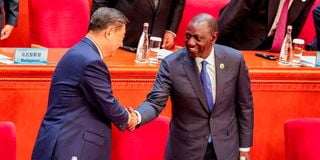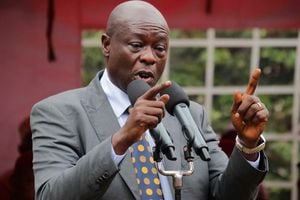China aid a path to prosperity, not a debt trap

President William Ruto of Kenya and China's President Xi Jinping shake hands during the high-level meeting on the Belt and Road Initiative in Beijing, China on September 5, 2024.
What you need to know:
- For many Africans, the benefits of new roads, railways, and ports are more visible and immediate.
- China’s policy of "request-based" financing is one of the best practices in the Global South development model.
The pledge by President Xi Jinping that China will provide $51 billion in financial assistance to Africa over the next three years reflects a relationship where a friend is mindful of the needs of many and offers a helping hand.
The decades-long bilateral relationship between China and Africa has seen many African countries experience significant development in areas such as roads, railways, ports, technology, and trade, leading to positive economic growth indicators.
Given this strong relationship between Beijing and Africa, it is simplistic to view China’s financial pledge as a path to a "debt trap," as some Western media portray it. These are sovereign nations that clearly understand the development priorities they want to pursue, in alignment with their national interests.
In contrast to China's focus on large-scale infrastructure projects, the West, through institutions like the International Monetary Fund (IMF) and World Bank, has emphasised intangible aspects of development such as capacity building, human rights, and governance.
While these initiatives are important, they often lack the immediate and tangible impact that infrastructure projects have on economic development. For many Africans, the benefits of new roads, railways, and ports are more visible and immediate than the outcomes of capacity-building programs.
Africa’s infrastructure deficit
China’s policy of "request-based" financing is one of the best practices in the Global South development model because the outcome is based on consensus-building, which avoids the so-called debt trap narrative. This narrative is largely promoted by those envious of the Sino-African relationship.
President Xi outlined 10 partnership action plans to be implemented over the next three years, covering areas such as mutual learning, trade, industrial cooperation, connectivity, development, health, agriculture, cultural exchanges, green development, and security.
China’s promise to fund 30 infrastructure projects will go a long way in addressing Africa’s infrastructure deficit. Those who allege that Beijing is burdening African nations with debt are hypocritical and insecure in their criticism.
When China paused infrastructure financing during the 2019 -2020 global crisis due to Covid-19, many African countries faced serious challenges in meeting their infrastructure needs, with numerous projects stalling. The critics, who often accuse China of debt-trap diplomacy, were nowhere to fill the gap left by Beijing.
The African continent, with a population of 1.3 billion, faces an annual infrastructure funding deficit estimated at $100 billion. To enhance intra-continental trade, it is essential to improve connectivity between regional blocs such as the Southern Africa Development Community, the Common Market for Eastern and Southern Africa, the Economic Community of West African States, the Economic Community of Central African States, the Arab Maghreb Union, and the Intergovernmental Authority on Development, as well as the African Continental Free Trade Area and the African Union’s Agenda 2063.
The writer is a Nairobi based journalist and 2019 fellow of China-Africa Press Center Program





